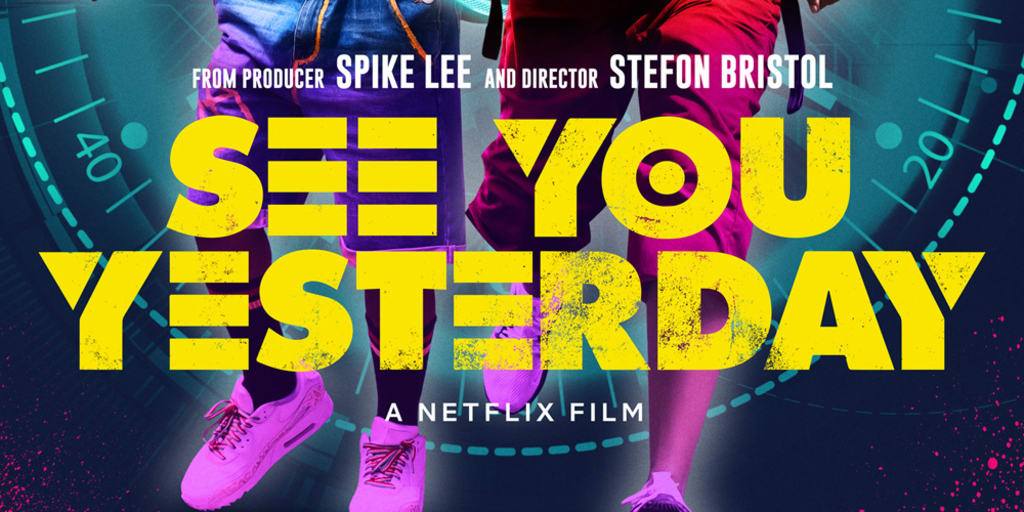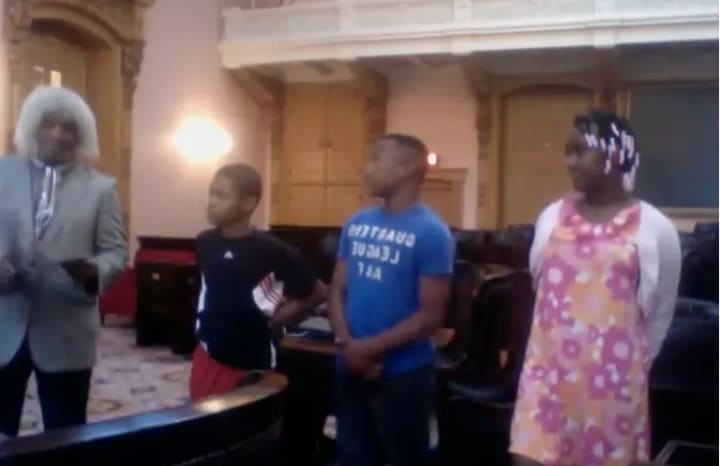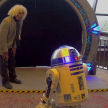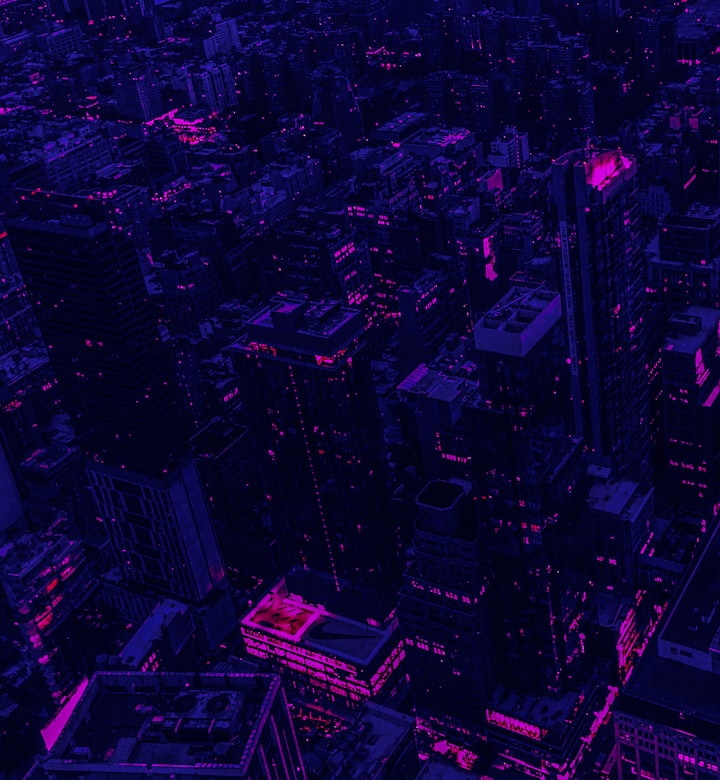Tackling 'See You Yesterday' at the Goal Line
A science review where I take the kid gloves off... and put the brass knuckles on!

Well, Spike Lee's production of Stefon Bristol's first film feature, See You Yesterday was released the 17th of May and I still haven't seen it, which is fine. I've seen enough to be hacked off that I will have to go out and lecture at STEM schools to offset the bad and pathetic way that Bristol and his writing accomplice, Fredrica Bailey, portray STEM education, physics and time travel. Why me? Because I actually am a recognized STEM educator and leading expert on time travel science. I've lectured to and tested kids smarter than the two characters in Bristol's fantasy flick, on such subjects as parallel universes, time travel, wormholes, and the nature of time, and I don't like it when people come along and relieve themselves in my field of endeavor—just so they can make a buck. When that happens, there will be repercussions and frankly, I have no second thoughts about making an example out of Spike Lee and his "mentees." As they used to say, "It makes me no never mind..." because I've proven my cred—which is unmatched by pretty much anyone else. That's right. I am that guy.
Case in point, the STEM program I created called the Oppenheimer Strain, named for J. Robert Oppenheimer—who felt that there are children truly smart enough solve problems in physics missed by PhDs like himself. I proved it conclusively with 4th, 5th and 6 graders from the OSU African American & African Studies Wexner Medical Center Math and Science Club. I tasked them with one of the errors I had found in Stephen Hawking's Mad Scientist Paradox from his 2011 TV special, Into the Universe with Stephen Hawking. The paradox involves a mad scientist who creates a wormhole generating machine that connects to the past by 1 minute. He then assembles a gun and walks over to the wormhole where he can see himself in the past, 60 seconds prior. He then shoots himself through that opening and we can see, from the view on that side, his getting hit and collapsing dead on the floor beside his machine and the single wormhole in the room that he was shot through. The majority of the children got the right answer—the highest percentage that I ever had, proving Oppenheimer's conjecture. To help them, I gave them a crash course in wormholes and temporal mechanics. The only clue I gave them was that they needed to know the difference between an "Out" door and an "In" door. That's it.
The exact Oppenheimer quote - exactly the way I proved it...

Watch the video and see if you're as smart as those 4-6 graders, who saw the answer after considering the geometry formed by the restrictions of "In" and "Out" doors. Clue: With the noted restrictions, there's something critical missing in the video... If you can't figure it out, then guess what? You are not smart enough to even have an opinion on time travel nor be allowed in any such serious conversation. If you realize then, that would include Stephen Hawking, you get extra credit at least! In his entire career, Hawking never contributed a single thing of substance to the time travel debate. I know. I wrote the only critical book on his career and work, Space Warps and Time Tunnels: The Infamous Legacy of One Stephen W. Hawking. I use the perception that he was some kind of time travel expert as a test of a person's knowledge required to be involved in time travel discussions, the hardest field in physics. Just saying.
So it is a hilarious to me that Bristol has his CJ character reading Hawking's A Brief History of Time, as if there's something related to learn there, while in real life, a 5th grade girl nailed what was wrong with the set-up of Hawking's Mad Scientist Paradox, in seconds. It just goes to show howoverrated Hawking was. Yeah. I said it. Here's how Peter Coles, of the University of Nottingham put it—"There's a tremendous gulf between the public perception of Hawking and the scientific evaluation of his contribution..." In other words, anyone wanting to send me hate mail can eat it with their breakfast cereal, 'cause it doesn't matter.
Real life STEM kids dealing with time travel science...

The little 5th grade girl in the background, right side, was the first to get the correct answer to the question about Stephen Hawking's Mad Scientist Paradox. I stopped her, as soon as it was apparent that she had it, to give the other kids a chance. The boy standing in the foreground is timidly giving his accurate response.
And getting officially recognized for it...

When I wrote my previous piece, Stopping The Clock On Spike Lee's 'See You Yesterday', I used 3 Buck Theater host Matt Jarbo's commentary as an introduction to what the movie is all about, so I'm returning to Jarbo to set up and discuss the controversial ending of the movie which is directly connected to the subject of time travel and Bristol's approach—which causes me to wretch.
So, here are my comments on what Jarbo reported on:
1. I mentioned this before, but I'm going to do it again because it is just so OBVIOUSLY ASININE! At :31 on the counter, Jarbo starts talking about this plan that these high school kids have to get into M.I.T.—time travel! Time travel doesn't get you into M.I.T.—it gets you into S-4, or an underground facility at Wright Patt or Brookhaven, NOT M.I.T.! It would probably get them disappeared because they would've proved themselves to be too young and naive to understand the National Security implications of what they were doing, by showing their tech off at a science expo! I know. I was a Grand Judge at the D.C. Science and Engineering Fair in 2011 and if you have something as radically sensitive as time travel, you don't show it off at a science fair! That's just plain stupid! You show something related and keep the rest SECRET. It's time travel. The implications and capabilities of that are obviously even beyond the cognitive thinking of the writers—they keep plugging it in the media as if it's a great idea.
2. At 1:10, Jarbo talks about how when CJ attempts to go back in time and save her brother from being shot by the police, it never works out, setting in motion what's come to be known as "butterfly effects" which are malarky. Anyone that actually believes the butterfly effect, the way that it is portrayed in movies—which is where every time you try to change something, it turns out worse—is an idiot. Identify the cause of this little mystery then—what are the mechanics behind that? C'mon, all you geeks and nerds out there. You're so damn smart—answer that question! I can prove you wrong, right now—it wouldn't be that way because it's never that way across the distribution of probabilities of how outcomes would turn out. In other words, sometimes it's good, sometimes it's bad, sometimes it's better than ever and sometimes it's the same as it ever was, but across a cloud where each manifests in a separate, parallel world. Oh, or did you forget your quantum mechanics as well as misinterpret chaos theory? Anyone using that trope is a moron in my opinion, for two reasons: they just accepted the original use of it as valid and didn't have the brains to look it up first, or they just didn't care. Bristol and Bailey are both.
3. At 1:18 there's mention of CJ going back to "reset" time after so many things go wrong. There's no such thing as the ability to reset time except in the minds of morons who have absolutely no idea of what is involved in temporal mechanics. I'm not kidding here. If YOU think I'm wrong, fine—you set up a public debate with a monetary prize for the winner and I'll show up, beat you handily in front of your friends, and take the money and go home. No quarter. No mercy...
4. At 1:52 Jarbo talks about how, when they can go back in time, they have to worry about running into their past selves because, "it doesn't alter the time line, it doesn't create a new, alternate reality, as we would've seen in let's say, Avengers End Game, but it does seem to follow all the other time travel logistics, set by movies before it, like Back To The Future and Time Cop and all the other movies... " Well, I saw Avengers: End Game andI was amazed when "Professor Hulk" laid it all out like he did, and CHEERED!
Okay, so he didn't say it exactly right, but CLOSE ENOUGH! More importantly, he stated that all those other movies ARE WRONG! Yes! Back To The Future IS a bunch of B.S.! That's something that people needed to hear and that I've been saying for years now. Otherwise, the beginning of the quote I cited above is wrong because each time they would go back in time, there would be copies of themselves because they were already there. The only way around that would involve advanced temporal mechanics which I'm not spending any time on here. What? Are you kidding me? The basic stuff is beyond this discussion. I'm not getting into mapping and temporal targeting techniques and the classified stuff...
EVERY event that would change the past creates a new, parallel universe copy of the past, otherwise known to geeks, nerds, and others—not qualified to authoritatively talk about the subject—as an alternate time line.
5. So at 2:18, Jarbo explains how some friend of our intrepid, time traveling heroes, comes up with a way to have gold plated motherboards increase the power of their machines to the extent that they'll be able to reset the timeline. STOP! As an R&D engineer, I've worked with gold platings in both circuitry and connectors and no amount of gold increases power or fidelity over the normal operation by that much.
6. 2:29. Time splice? Increase the power to create a time splice? You can't splice time without splicing space. They are together, the space-time continuum. The only thing possible like that would be to translate yourself to another quantum outcome which has nothing to do with power output. Power requirements are purely related to relativistic processes which offer NOTHING to true time travel. Don't believe me? Essentially, all time travel events could be viewed as time splices because you're connecting yourself from one point to another, discontinuously, which is a "splice." But not just in time, but a parallel world branch of the universe. So there is no power increase involved and the solution was there all along in the film except as writers, Bristol and Bailey shouldn't be allowed anywhere near a time travel script writing assignment. Obviously.
7. At 3:16. Where time is supposed to be? That makes no sense in the overall scheme of things. Because of the Everett Interpretation, the parallel universes model, in other universes other outcomes took place. There is no such things as time as it's supposed to be within temporal mechanics and the Everett Interpretation. There is no prime universe, just as in Einstein's Relativity there is no absolute time, no prime frame of reference, which is why a solid understanding of temporal mechanics is needed when dealing with TIME TRAVEL!
The Temporal Relocation Packs work (:39) by breaking down their molecular structure enabling them to travel through a worm hole and reappear in the desired time. Here's the problem. 1. The narrator of this report may have mis-explained it but breaking down something's molecular structure is akin to disintegrating it. The idea (though impossible) would be to shrink down to enter the wormhole but there would be problems with stabilization, let alone selecting the right one, or having the technology to influence where the wormhole would open up to—something requiring H. David Froning's approach to conditioning electromagnetic fields. The kids have none of that—technique, technology or knowledge, so that's a no-go. 2. Once they get through and back in time, how do they recover their normal size? 3. The narrator points out that he thinks the use of wormholes is "especially interesting" (:45) because of their reference in A Brief History of Time. If that book was such a solution to time travel issues, then why did Stephen Hawking never commit to time travel being possible?! Oh! You didn't know that?
At 1:24 in the clip it is pointed out that Michael J. Fox asks CJ the main question of the film: "If you had that kind of power—time traveling, what would you do? What would you change?" This exposes a main flaw in most time travel stories and in the public's view of what it is and how it would be used. The bottom line is that you can't use time travel to change the past so that it will also change the future. PERIOD. Why not? Because it has to do with how the physics of reality works and the geometries that are manifest. This is what I mean—The Copenhagen Interpretation of quantum mechanics is the most widely accepted interpretation. It posits that there is only one outcome per measurement. What is a measurement? It can be anything from a literal measurement to an observation of an event. So we all know what the past is—that collection of events that have already taken place.
So, Copenhagen would appear to ban time travel to the past. There's a loop hole, however—there's nothing else really that seems to prevent time travel as far as the physics goes, which brings us to the solution—the Everett Interpretation, which allows for the existence of parallel worlds. In fact, these worlds are not only coming into existence all around us almost every millisecond, but they are in fact the result of any time travel or time altering action. Now get this—the act of time travel to the past causes a new, parallel universe copy of that past into existence—with you in it. That means that the objections concerning added entropy to the past and conservation of the energy from the 2nd law of thermodynamics, are resolved because this past isn't the exact same one. How could it be—with you now there?!
So time travel—true time travel—isn't literal travel at all, but a translation of you from where you are, into a new present which is a copy of the past that didn't exist until you induced time travel. The functioning of this process is no different from the way the universe branches off all the time already—a process called decoherence.
Now, here's the freaky part: If a couple of really smart high school kids knew everything that I know about time travel technology and theory, there's a good chance that they could, in fact, figure out time travel in their garage. They'd probably get themselves killed, or lost in the past somewhere (and by that I mean, eventually killed) but the premise of Bristol and Spike's film could actually happen. But of course, it wouldn't resolve CJ's problem. She could see her brother again but not bring him back with her without taking him from herself in the past. There's no changing the past so that she can return to the future with those changes in effect because there is no path way for that to happen. This isn't fantasy—it's physics facts. The two time periods are discontinuous. People just say things and engage in hand waving. I demand an explanation in physics of how pictures change after they've been printed (as seen in both this film and Back To The Future), or people just fade away because of something that happens in the past. That would imply a causal connection between the past and the present after the fact and that just isn't the case. It's why we say that time travel is discontinuous. There's no continuing connection between those two things unless a wormhole that stays open is involved, which would only provide for direct changes from the past to the future, through the wormhole, and anyone that's serious about this topic has given up on using wormholes and that includes me. They're just too much hassle to be worth it—unless moving large amounts of personnel and material to one specific place is involved (hint, hint—wink, wink). That's after you figure out how to enlarge and safely stabilize them. CJ and Sebastian don't do that——hence them having to be shrunk down which indicates the ignorance of Bristol and Bradley—all theoretical discussions about using wormholes involve enlarging them because there's no way to shrink people.
As for Michael J. Fox's question—I'd go back to 1971 to survive the future I see coming here, which I feel is not survivable—but for a few. Read my blog at Quora.com.
At 3:30 in the clip, it talks about CJ being able to reverse the spin of electrons to produce anti-matter, an idea that doesn't seem kosher according to the sources I've looked up, seeing as how that's outside my field. However, it's the use of that subsequent anti-matter that I have a problem with that I can address—at 3:34 the narrator says that this would create enough power to travel two times the speed of light. STOP! This is where we go from sci-fi B.S. to STEM B.S. Nothing with mass, which electrons have, can go faster than the speed of light, let alone 2 times faster. This is where Bristol and Bailey show they have absolutely no right to talk about how this flick promotes science and STEM because what it does is push false and misleading information unnecessarily and any time the two of them want to debate that, they can bring it. I'll meet them anywhere, to have this out in a debate—because as someone who actually tries to introduce advanced concept science and tech to young minds who yearn to know more about these subjects, Bristol and Bailey are just posing for their own benefit. In fact, I'm sending them an official challenge to that effect. We'll see how they stand up for STEM then...
The rest of the video clip has more examples of actions taken in the movie which are "not even wrong"—the phrase used by scientists to insult things that they find pathetic beyond words.
So, unlike what the nerds and geeks and clueless pop media think, actual time travel is on the horizon because of researchers like me turning our backs on the pathetic pantomime that is relativistic based time travel and instead, looking at the confluence of quantum mechanics, information theory and temporal mechanics. As seen below:
Experimental evidence of how time travel would work and that it can...

A photo set proving parallel universes in an experiment: Top: Laser fired with the accompanying hits & reflections within the step-up staging. Bottom: a single laser hit with no laser fired or reflections anywhere to indicate a laser fired within the set-up. The second photo is from the new universe copy where in its past (the point of decoherence), a laser was fired. However, here there is just a hit from nowhere. An anomalous result, just like a time traveler suddenly appearing from nowhere. But in this, the laser hit appears as part of the new universe and not coming into it. It is, in effect, a time splice. This was taken from the experiments described in the paper, Using Todd Rundgren's Song, Parallel Lines To Prove Hugh Everett III's Parallel Worlds.
So, there you go. A detailed explanation as to why See You Yesterday is SOOOO WRONG and sadly, it didn't have to be. However, it matters, especially when Bristol and Bailey want to get some sci cred for the focus on STEM and science and then they don't even respect the fields enough to get consultants so they can appear like they even know what they're talking about. To prove that point, this is how stupid these two are when it comes to sci-tech, as shown in an article from Revolt:
"To work on the mechanics of the TRP's, they put on Oculus Rift virtual reality headsets, while manipulating holograms. While this is a science fiction film, which means there is artistic license to exaggerate a bit, using a VR headset to work on holograms is like Kelly Rowland sending a text message using Microsoft Excel in the "Dilemma" music video. Bristol and Bailey think the time travel was handled with care, and much better than how Avengers: Endgame did, which Bristol considers 'terrible'."
Well, that proves that sci-tech is pretty much beyond the cognitive grasp of these two. But to put the final nail in their coffin, check this out, from Bailey, in the same article:
"Stefon and I did a lot of research to try and look into the basis of time travel, and real-world research on time travel," Bailey said.
LOL! And you can clearly see the pathetic, asinine, stupid product that was the result of all this so-called "research" they did! They might as well have made a movie where the moon is still made of green cheese! I rest my case, but not my fight. Just like I'm not forgetting how Malcolm Barrett tried to pull one over on his fan base by claiming he was a time travel science buff and then tried to smear me with lies. Didn't work.
Speaking about bad time travel, there's a new Terminator movie coming in November. It was the sequel to the first film of the franchise, that finally forced me to consider the true physics of time travel and if at all it were possible. The rest, as they say, is history.
I'll be BACK...
About the Creator
Marshall Barnes
The
internationally
noted
R&D
engineer
and
conceptual
theorist






Comments
There are no comments for this story
Be the first to respond and start the conversation.